Intel’s Arc A750, A770 Prices Revealed: Mid-Range is Back
Intel Arc A750 and A770 are about to reset pricing expectations on October 12. Intel Arc Alchemist has been in development for several years, and after delays and misstarts, we're finally in the home stretch. The Arc A770 and A750 will launch on October 12, and they're setting their sights firmly on the midrange market for the best graphics cards.
Intel provided additional details on what we'll see when the cards arrive in just a couple of weeks. Earlier this week, during the Intel Innovation keynote, Intel CEO Pat Gelsinger revealed a starting price of $329 for the A770. But which A770 was Pat referring to?
It's the A770 8GB model, to the surprise of no one, but the other Arc A700-series cards are priced equally aggressively. Intel's own Arc A770 16GB Limited Edition will cost $349, just $20 more than the baseline A770 8GB. $20 for double the memory? Yes, we'll take that in a heartbeat, even if it probably won't matter that much in most games, at least today. But the bigger deal is arguably the Arc A750, which will have 8GB and a starting price of just $289.
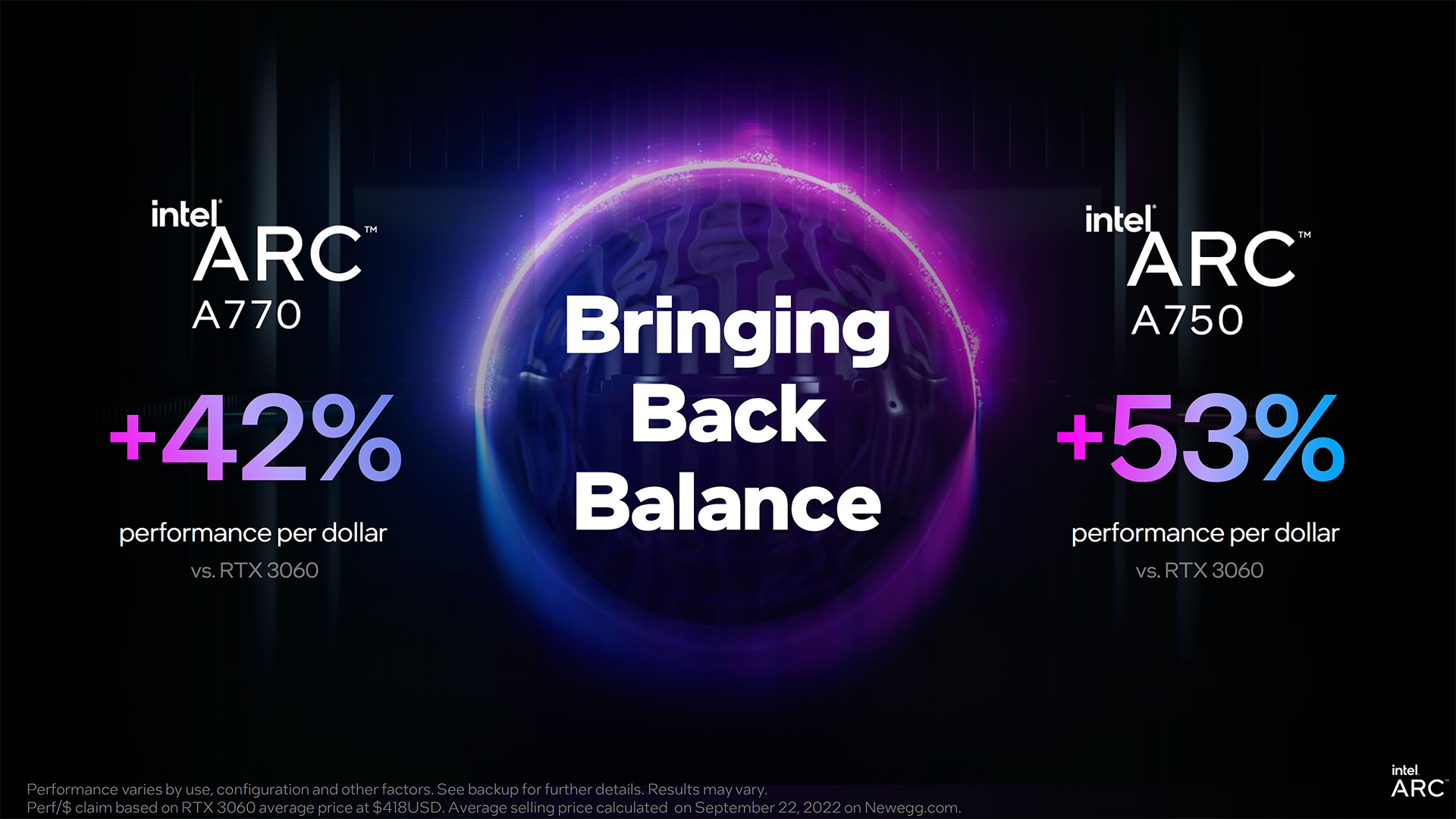
Intel's not being shy about performance comparisons, going straight after Nvidia's nominally $329 RTX 3060 — except that actual GPU street pricing for that card still starts at $369. Amazon has the PNY RTX 3060 XLR8 for $377, while Newegg has the MSI RTX 3060 Ventus for $369 (plus a 15% off code right now if you hurry). That might be the first time we've seen an RTX 3060 go for less than its MSRP since it first launched in January 2021.
Even at price parity, though, Intel still thinks it may have the upper hand. To that end, it provided a full suite of 67 gaming benchmarks with the A770, A750, and RTX 3060. The games were tested at both 1440p high and 1080p ultra, which seems a reasonable target for midrange hardware.
Intel also provided several "bang for the buck" slides showing the A770 and A750 going up against the RTX 3060, but the catch is that it used a "current" price of $418 for the RTX 3060. That might have been the going rate for the card last month, but GPU prices are quite volatile right now, and we're able to find much better prices just one week after Intel collected its data.
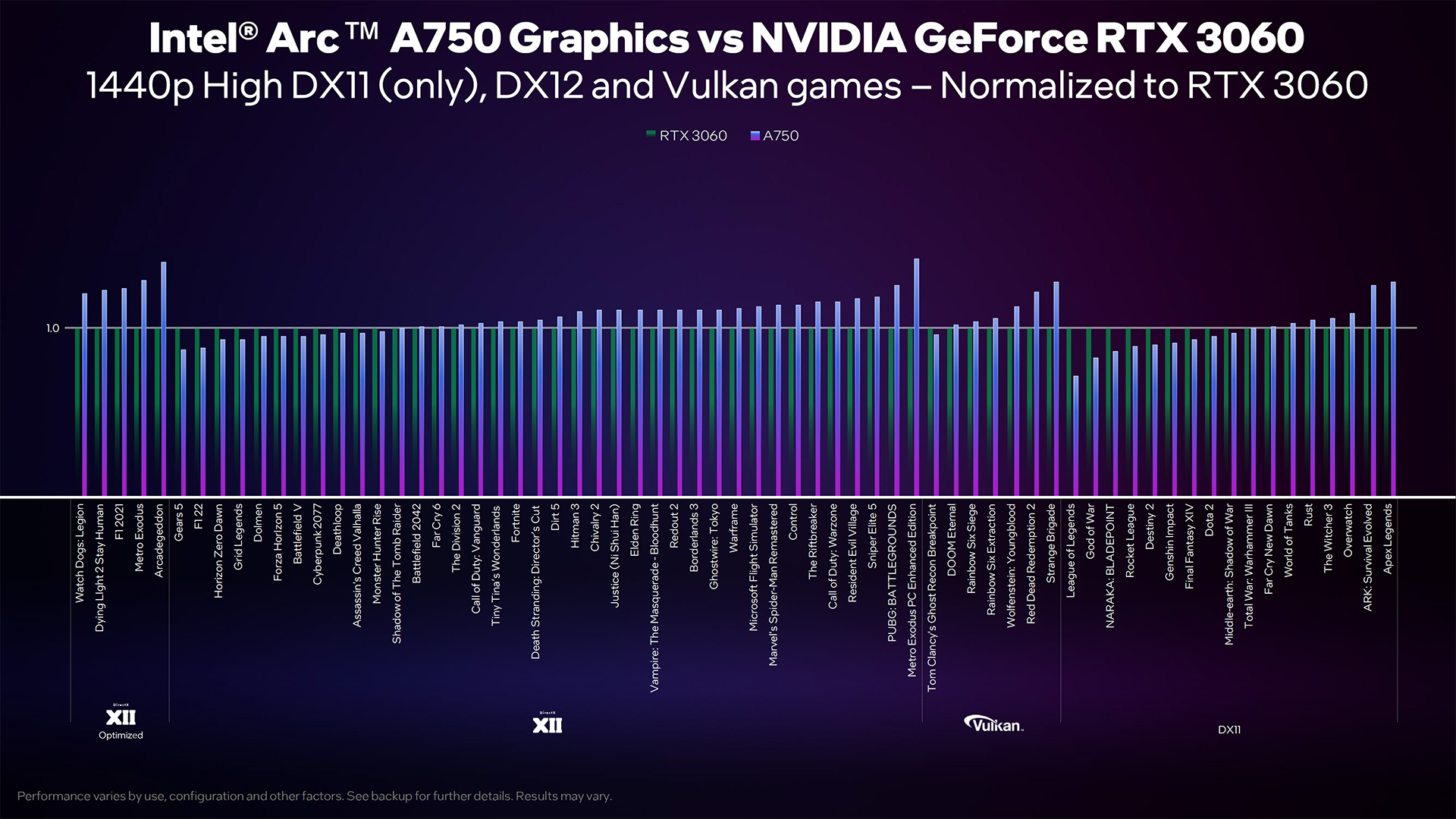
As with all manufacturer-provided benchmarks, we can't vouch for the performance data shown in this slide. Intel tested both cards with a Core i9-12900K, 32GB of memory, and an Asus Z690 DDR5 motherboard. While it didn't show the raw framerates, even the lower-priced Arc A750 showed generally better performance across the test suite.
Intel made a point of testing games that use all three major graphics APIs as well: DirectX 12, Vulkan, and DirectX 11. Games that support DX12 or Vulkan were tested using that API, as for Intel that generally means better performance. That might not be true of the RTX 3060, however, where DX11 at times still runs better than DX12 or Vulkan — again, a dose of skepticism is certainly warranted.
DX11-only games not surprisingly remain the lowest performing class overall, with about ten of the 17 games in that group showing better performance on the 3060. The DX12 titles meanwhile showed Intel Arc A750 leading in 32 of the 43 tested games, and in Vulkan the A750 was ahead in six of the seven games.
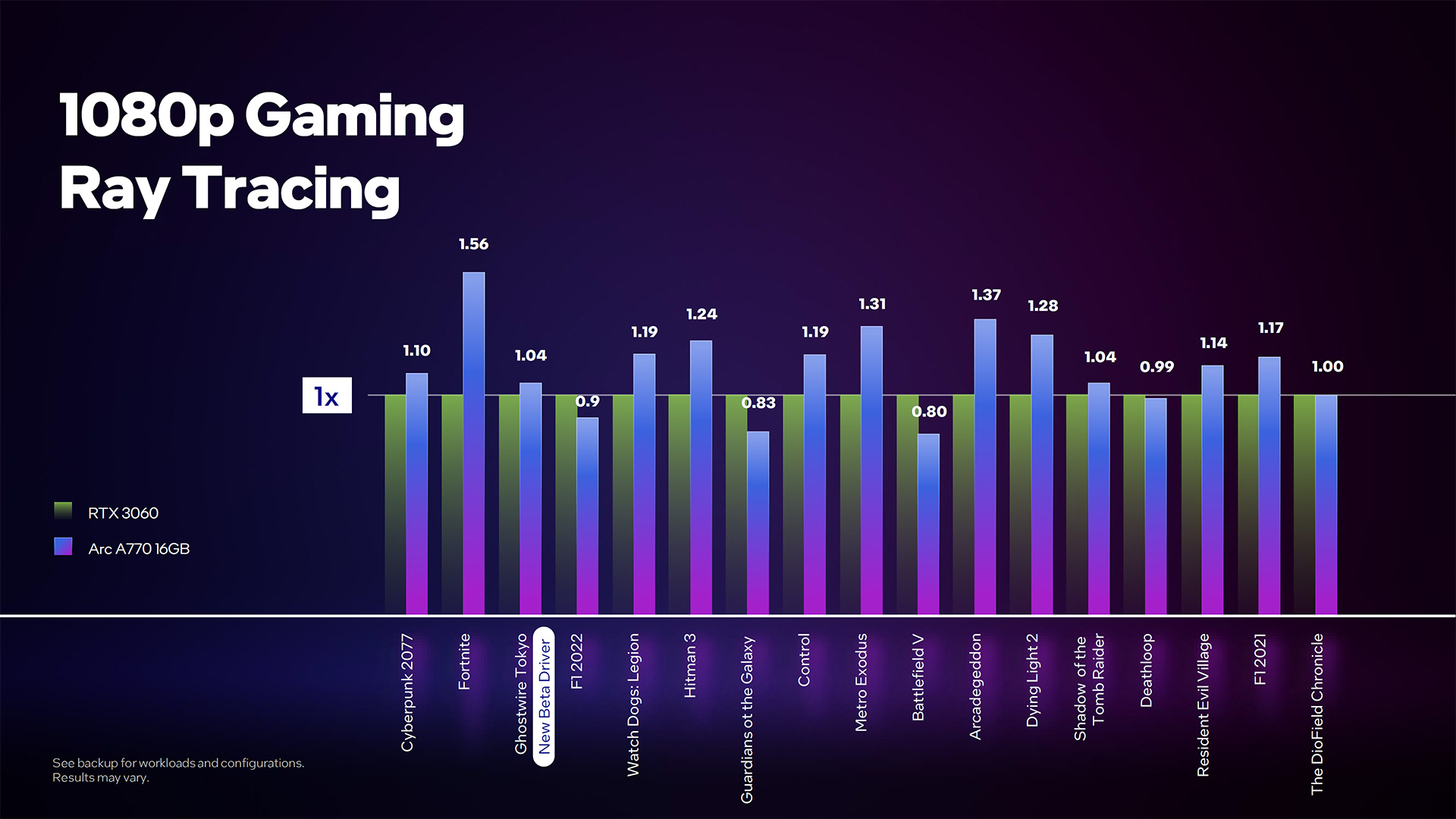
Unlike AMD, Intel isn't obviously avoiding comparisons in ray tracing games. It also showed off performance in 17 different games that use ray tracing. Even there, an area where Nvidia has traditionally reigned supreme for the past four years, the Arc A770 was faster in 13 of the tests.
Intel also discussed how building the Arc drivers using the integrated drivers as the starting point proved problematic. It's worked hard over the past several months to improve the situation, and that's beginning to pay off. The DX12 Optimized titles are games where Intel has specifically delivered targeted performance improvements, while the other DX12 games are just using standard code. As time passes, a lot more games should start to fall into the "optimized" category, with commensurate performance.
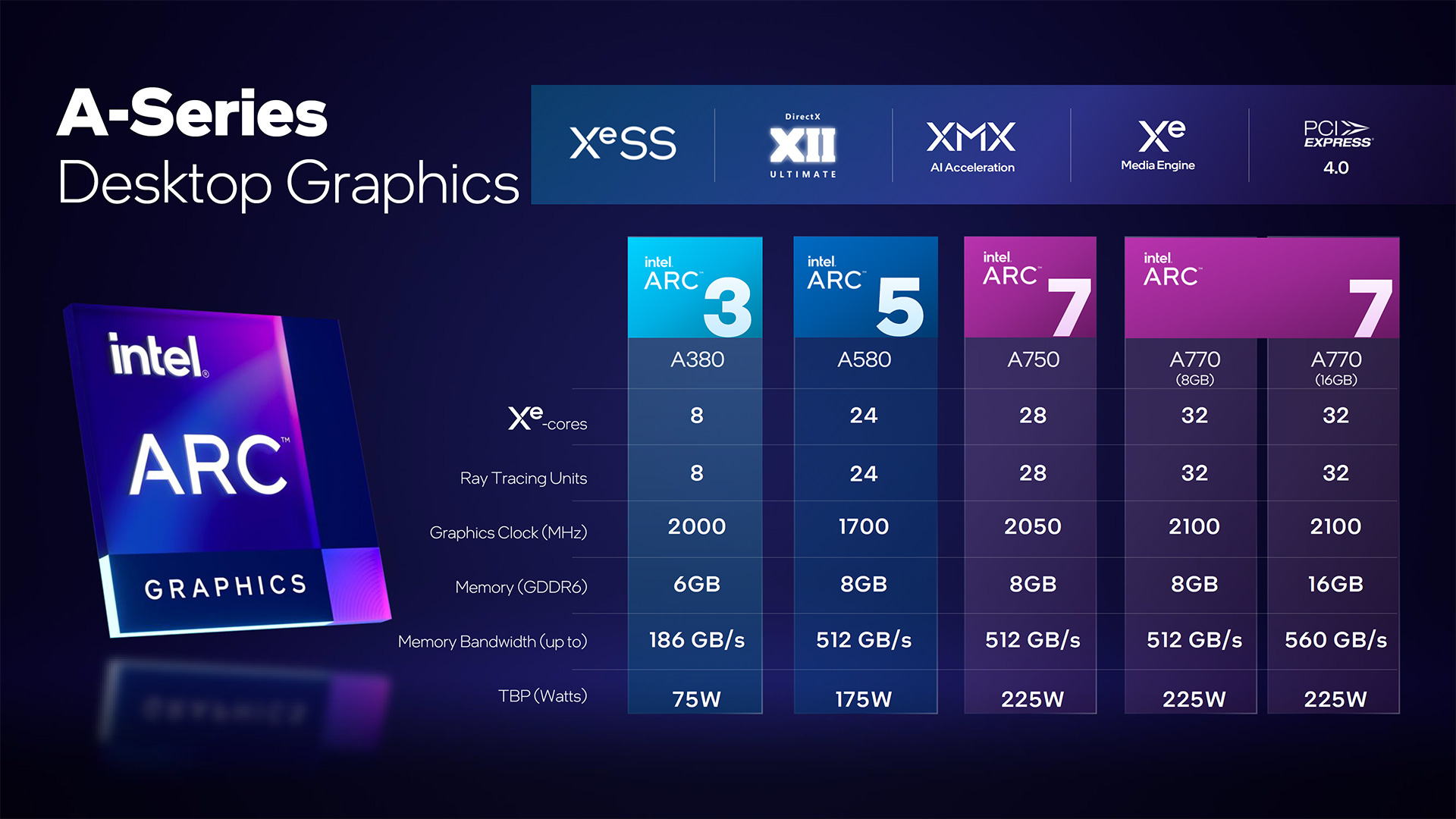
The full details of the Arc desktop lineup remain unchanged, but it's nice to see the A580 still waiting in the wings. That won't be launching on October 12 alongside the A700 cards, but given the $289 price point on the A750, we can't help but wonder how low Intel will go. $249 would put it right against the RTX 3050 and RX 6600, though AMD's card easily outclasses the 3050 at that price point.
That brings up another interesting topic: How do the Arc A750 and A770 fare against AMD's RX 6650 XT starting at $300? That's typically 10–20% faster than the RTX 3060, according to our GPU benchmarks hierarchy, at least in our standard non-ray tracing test suite. (In the DXR suite, the 3060 ends up being 25–30% faster.) Things could be close, which is why we still need to run the benchmarks ourselves. That will be happening over the next two weeks as we prepare for the retail launch.
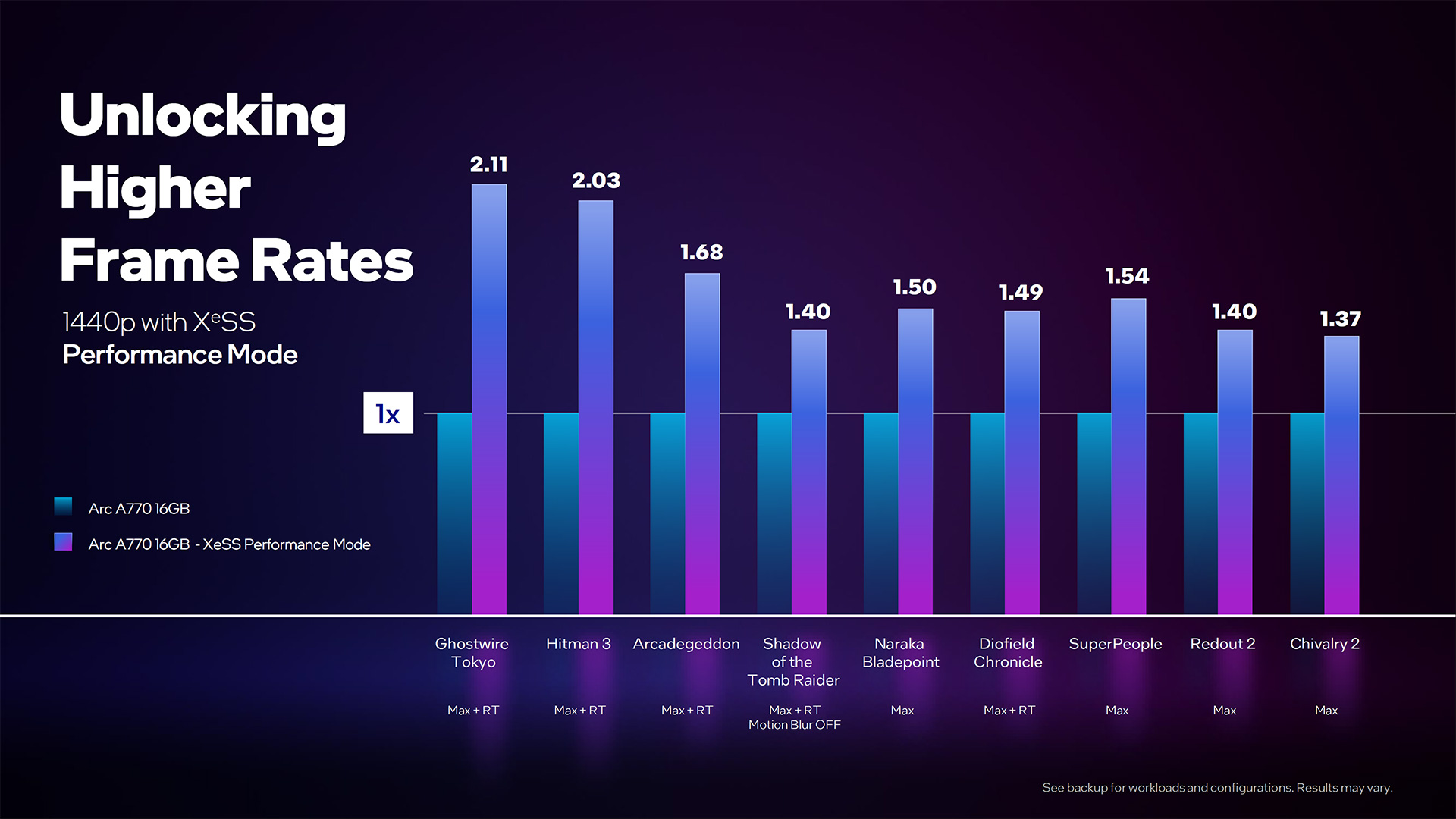
There are other things to consider as well. Standard apples-to-apples gaming performance is a good starting point, but Nvidia has a lot of games with DLSS support now available. At present, there are only a few XeSS-enabled games. Intel showed performance improvements ranging from 37% to as much as double the fps with XeSS Performance mode at 1440p.
We tested Shadow of the Tomb Raider with XeSS earlier this week, and a few other games are now publicly available with XeSS support (like Death Stranding). On the A380, XeSS was a bit problematic, but Intel says a lot of that might be due to trying to scale down the algorithm to a significantly slower GPU. We'll see how it does on the faster Arc GPUs soon enough.
But now Nvidia has DLSS 3 waiting in the wings, clearly trying to stay one step ahead of the competition. That's not coming to RTX 3060, however, and who knows when we'll see an RTX 40-series competitor to Arc A770 (our guess: next spring).
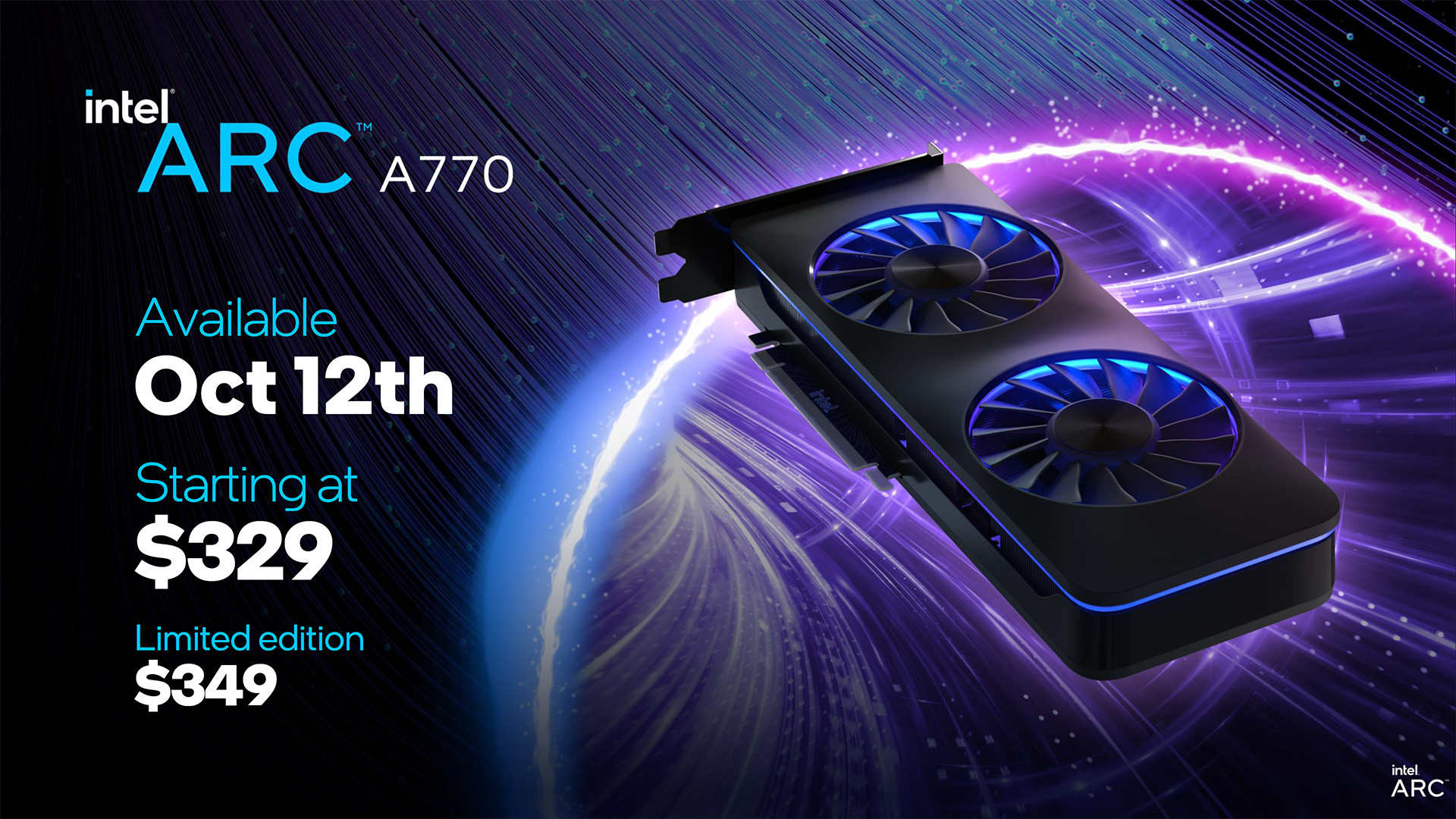
Intel Arc GPUs are set to launch in just a couple of weeks, and we're excited to test them out and see how they stack up to the AMD and Nvidia competition. We're also glad to see a potential true mid-range GPU launch for the first time in far too long. Intel almost certainly wouldn't have priced Arc this low had it been ready six months ago, but fears that it might try to stick to earlier rumored pricing are at least safely put to rest now.
As Intel shifts from the Alchemist launch over to Battlemage, which it once again reiterated is where most of the graphics team is now working, we can only hope it will execute better on Arc. The A750 and A770 both look promising right now, and we'll see them in action soon enough. But at this point, we're now looking on to AMD RDNA 3 and Nvidia Ada Lovelace. The sooner Battlemage can join the fray, the better.
The full presentation deck can be viewed below. Again, performance per dollar data needs to be taken with a healthy helping of salt, as the 3060 prices have dropped potentially $40 or more in the interim. And who knows where they'll be in two more weeks when Intel's competing cards officially arrive?
Get Tom's Hardware's best news and in-depth reviews, straight to your inbox.
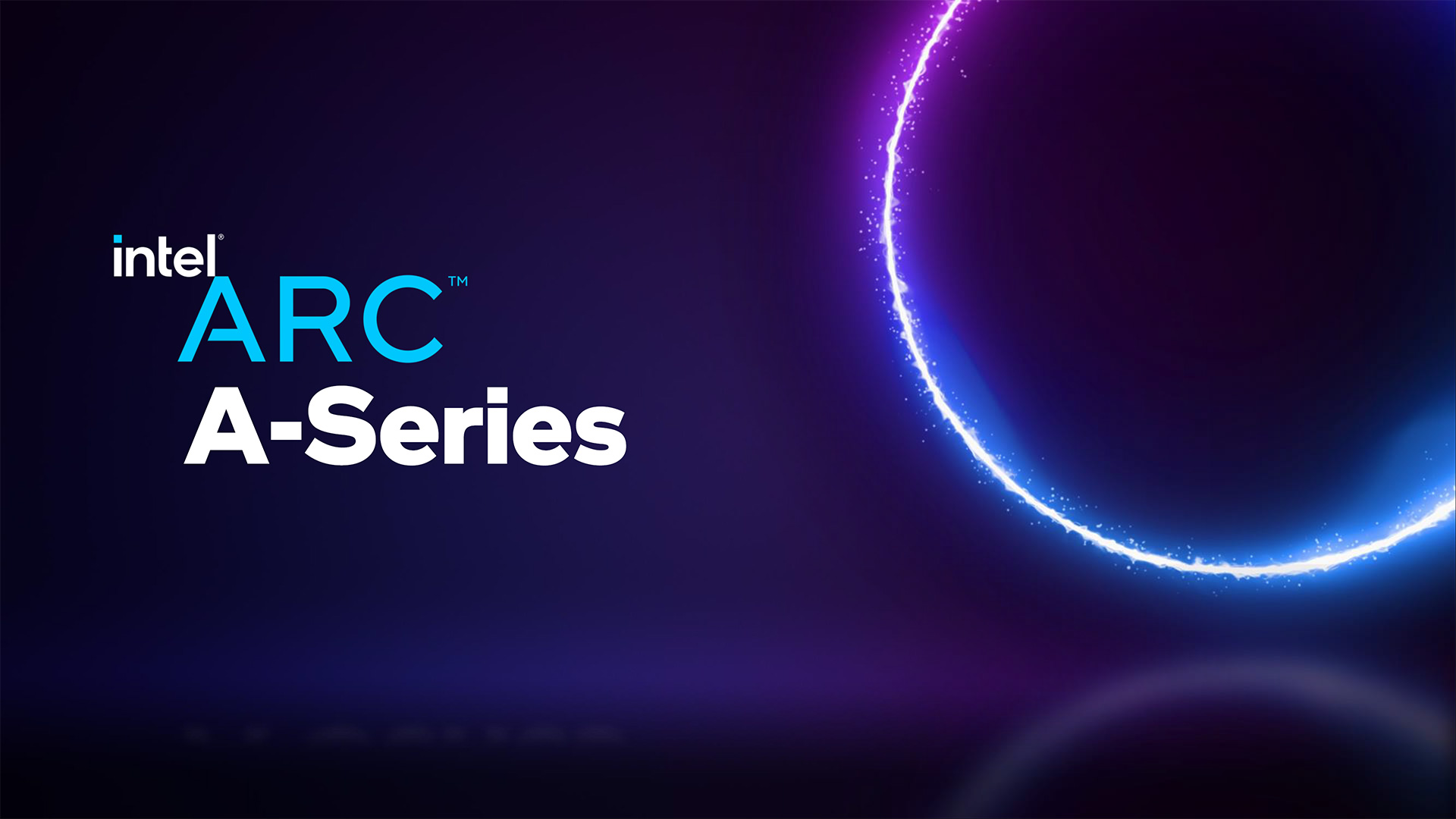

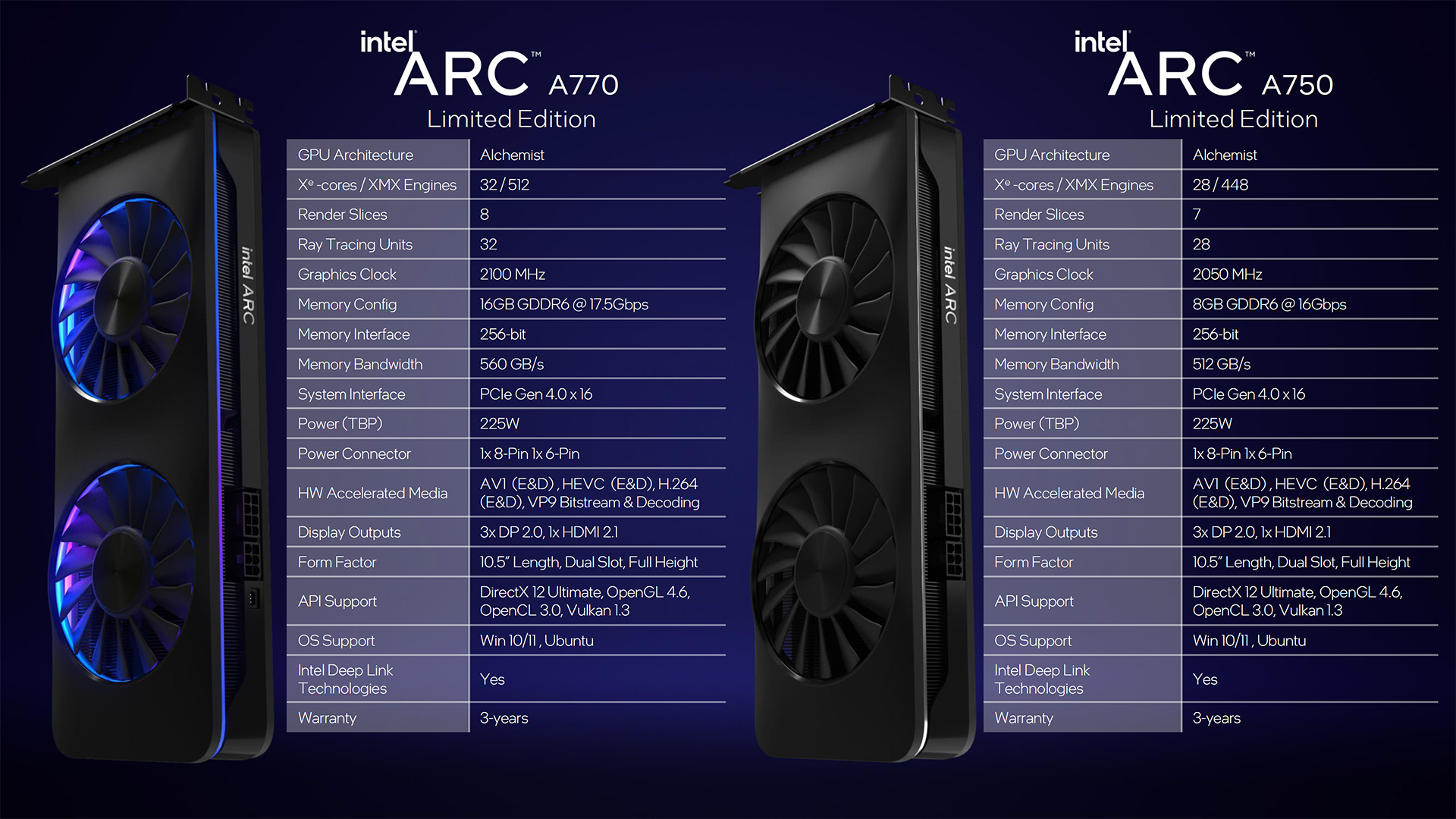
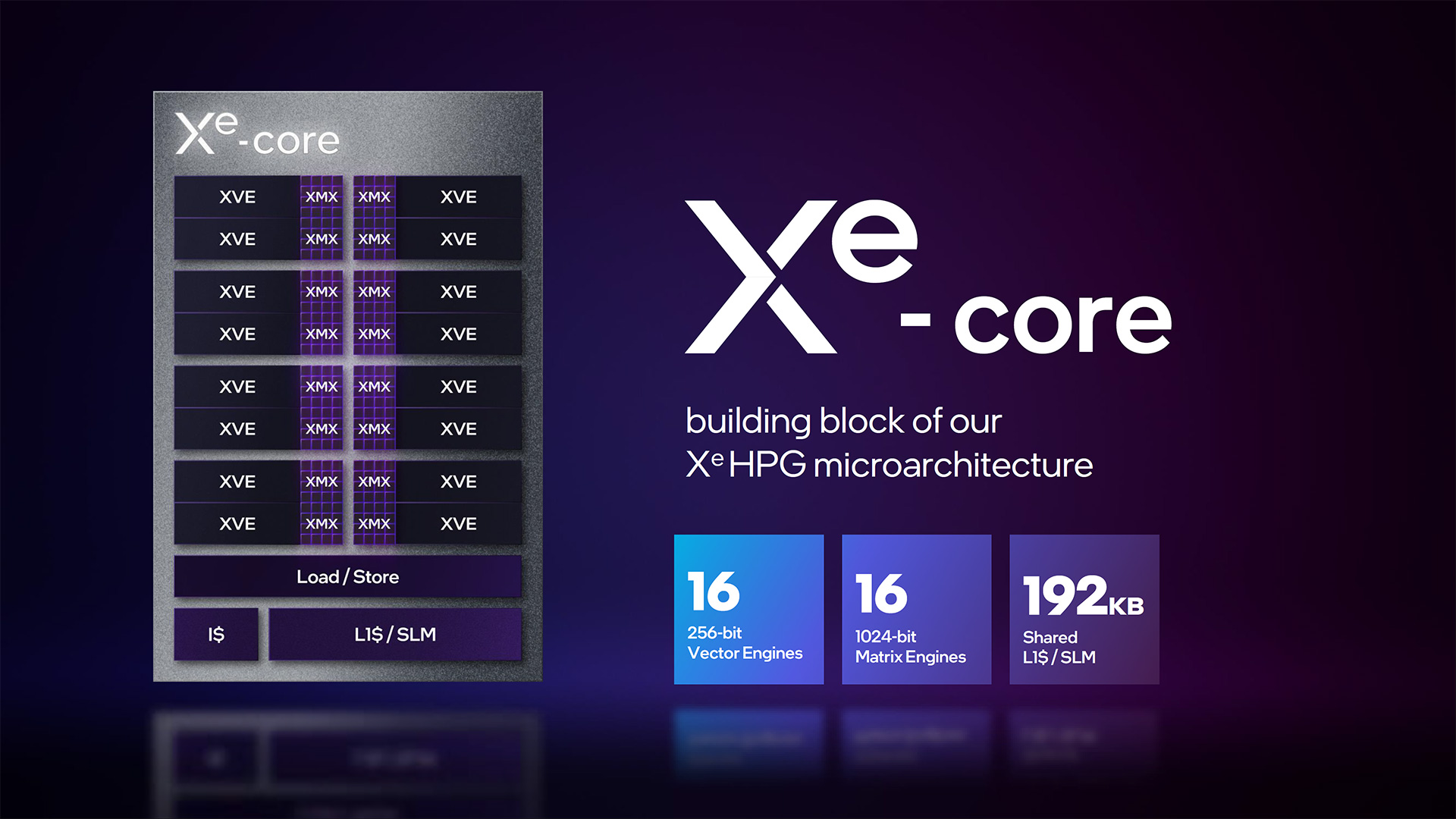
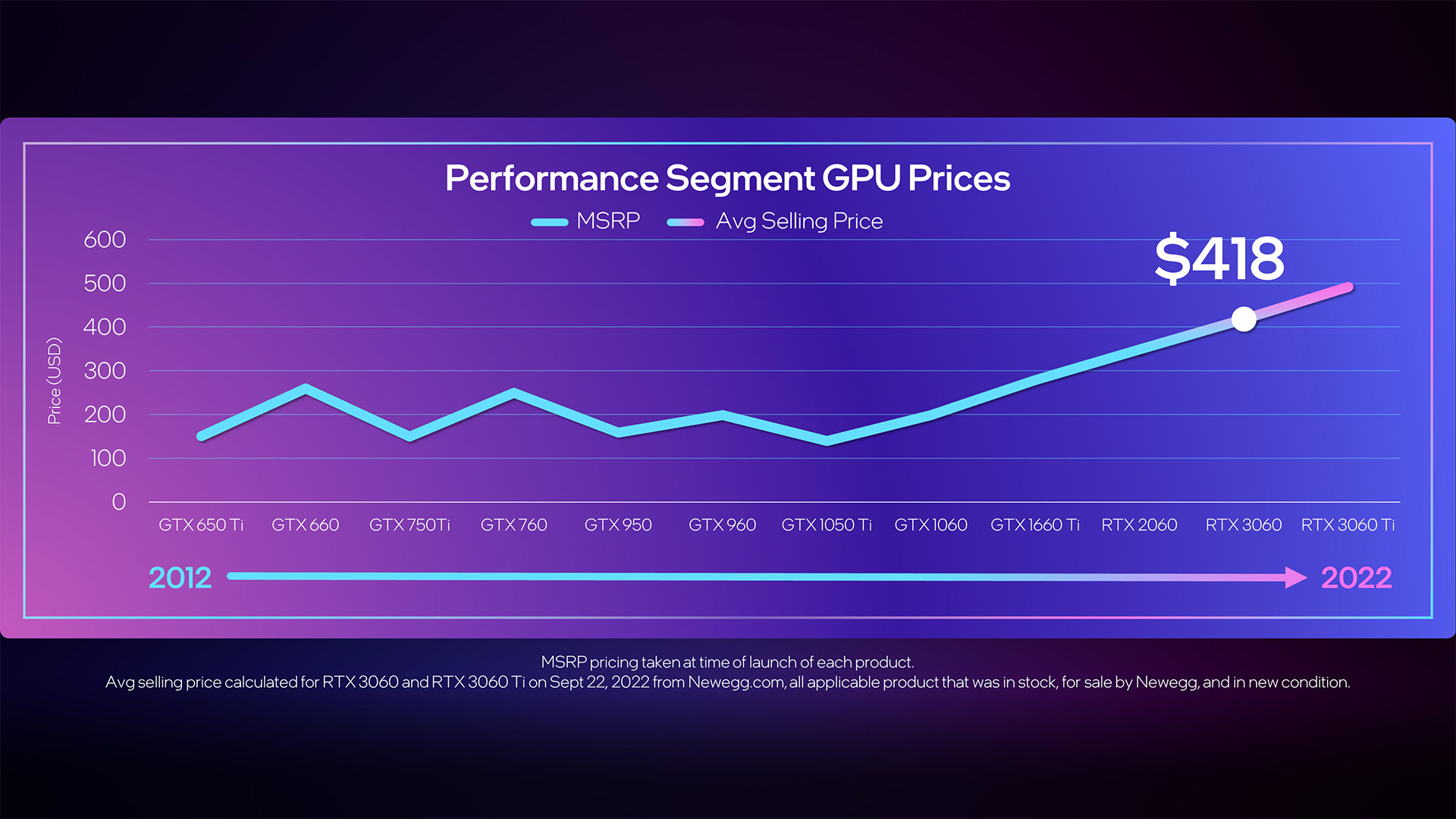

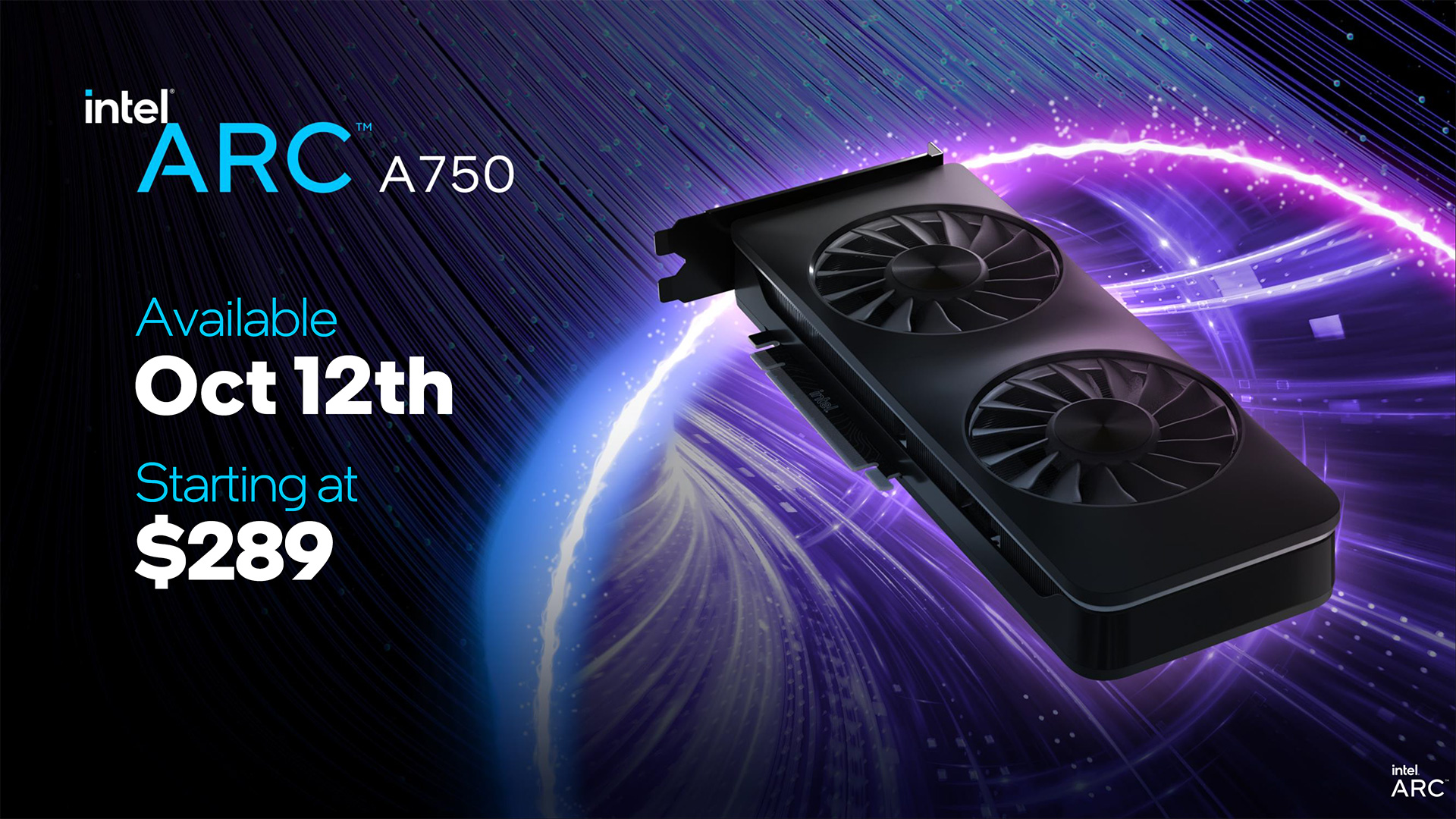
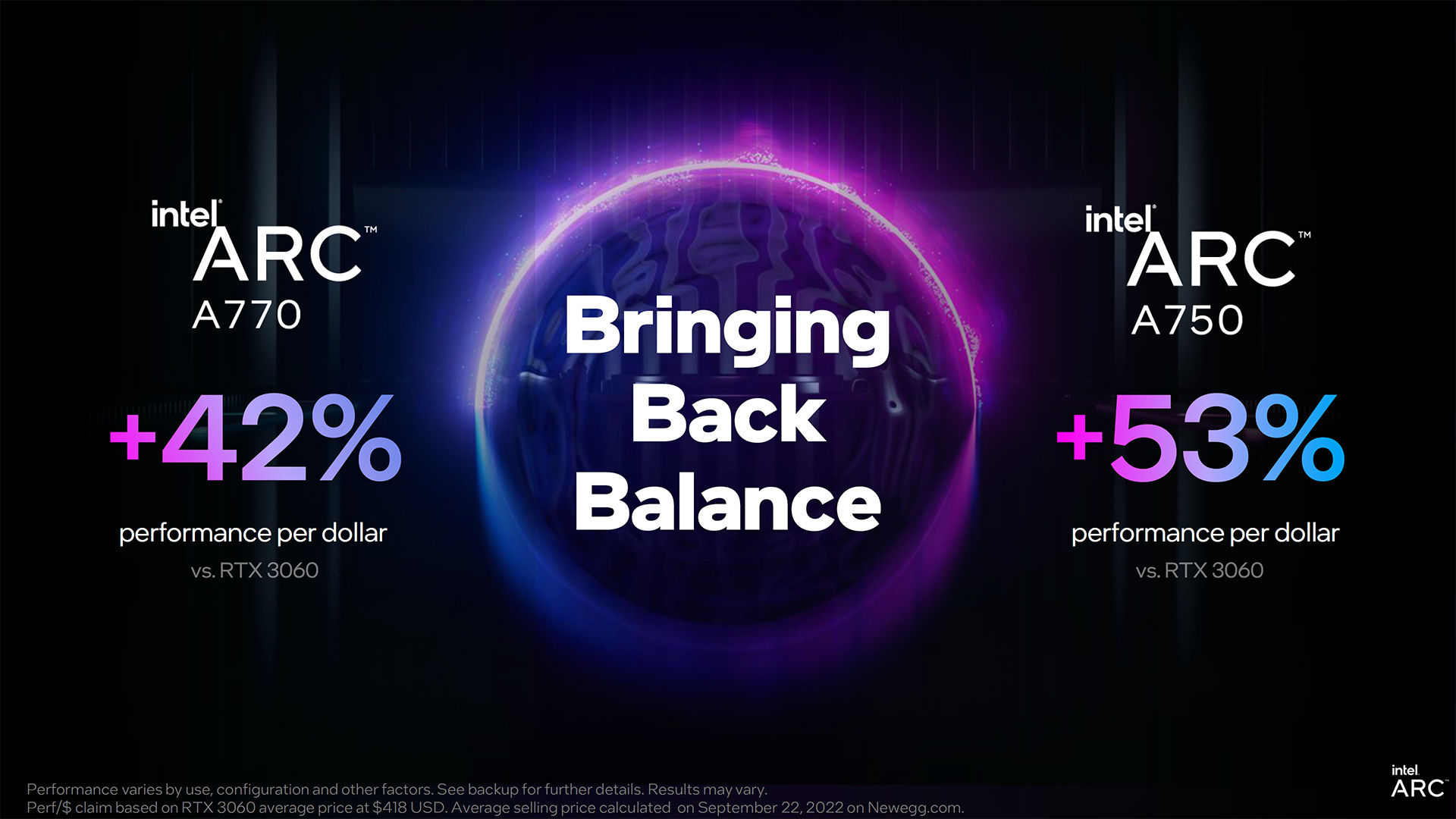

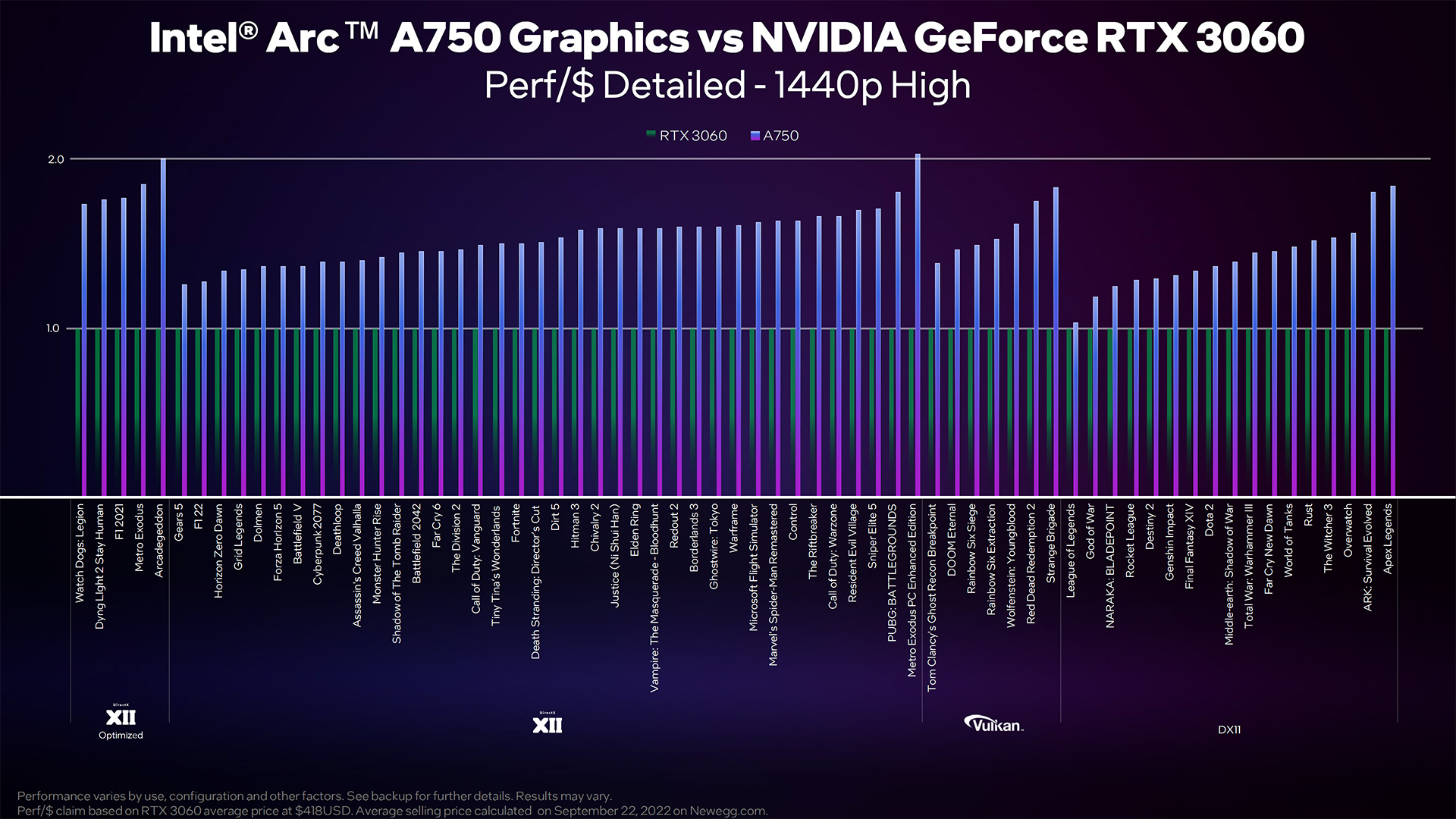
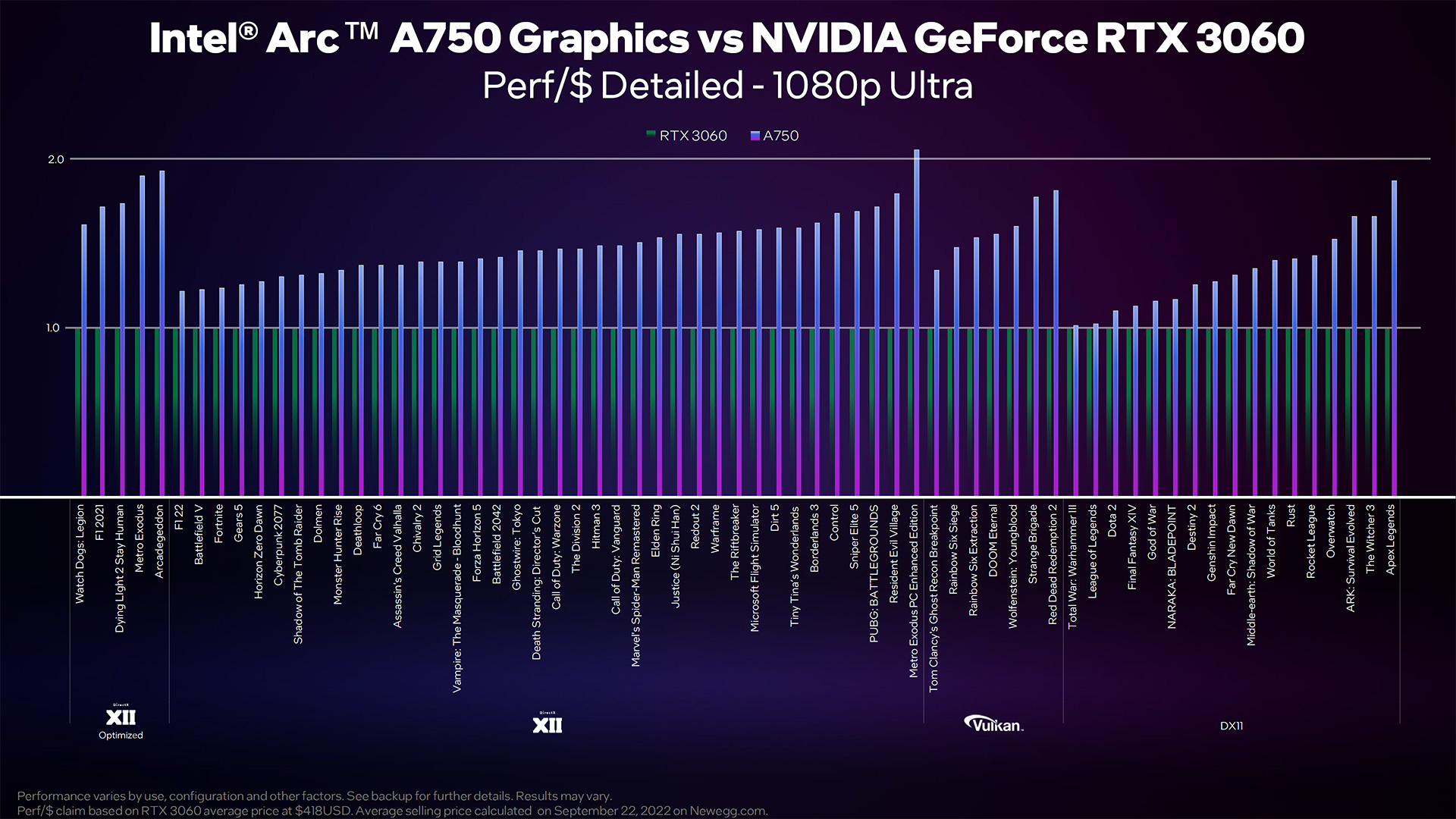
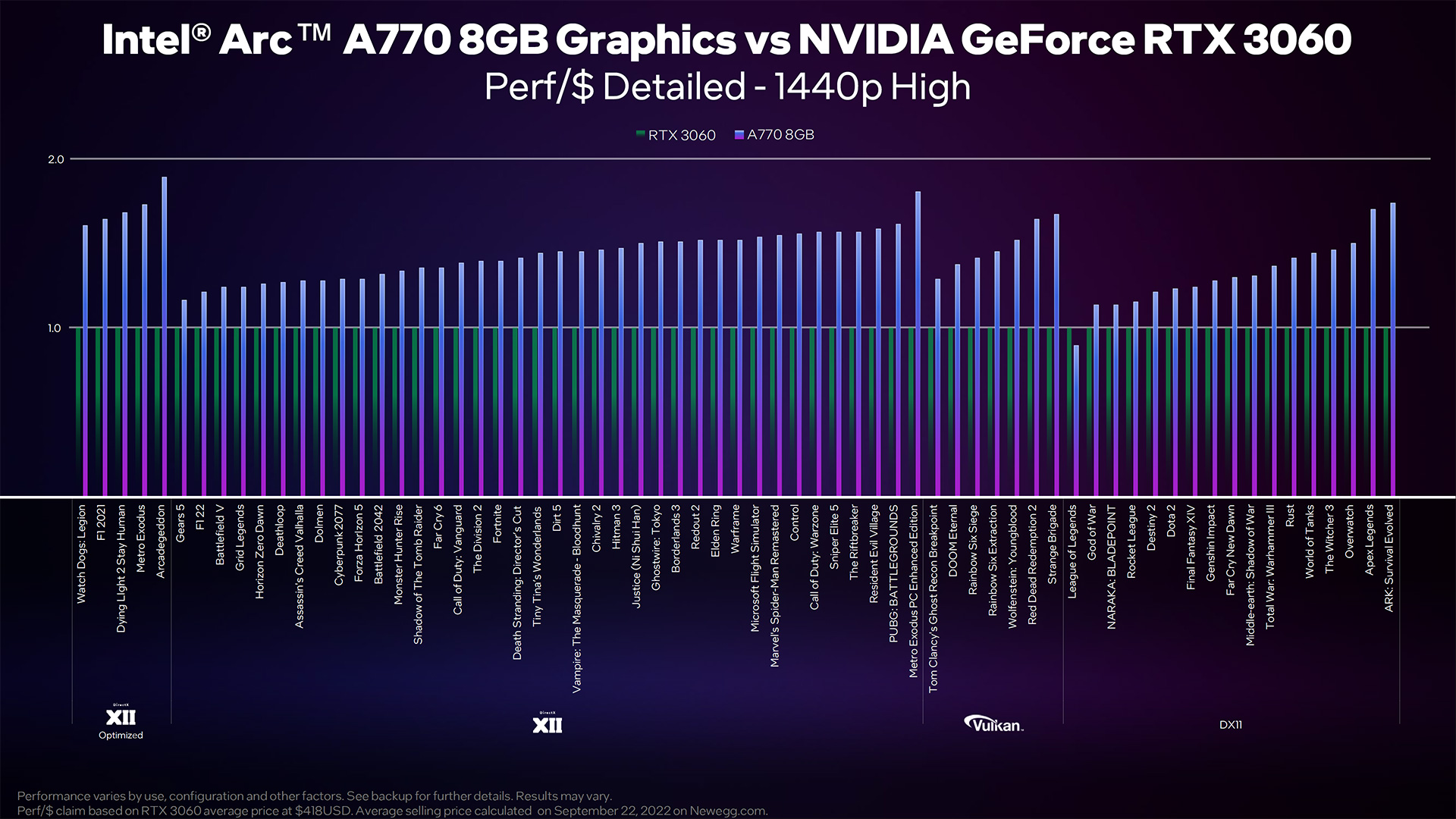
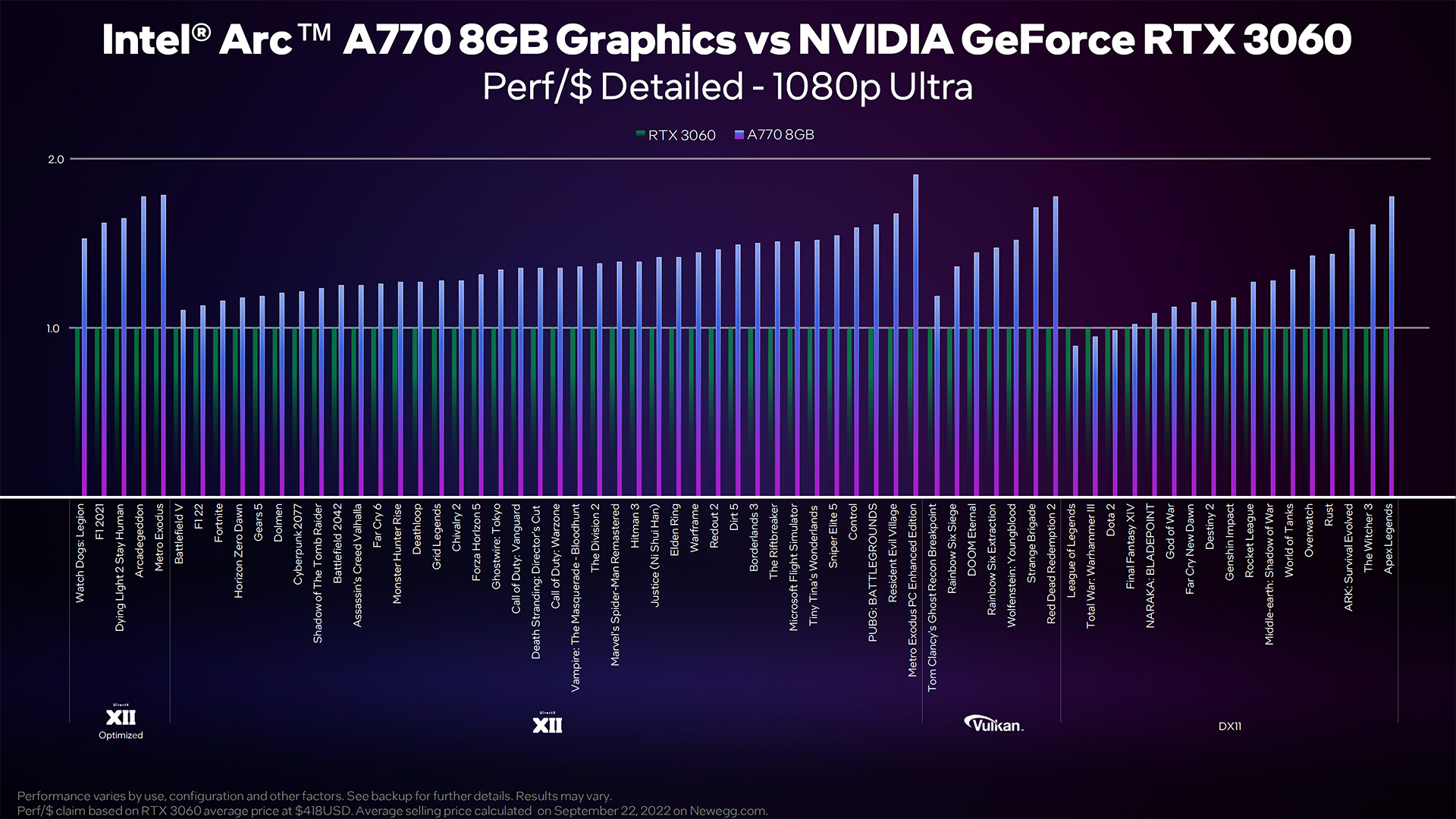
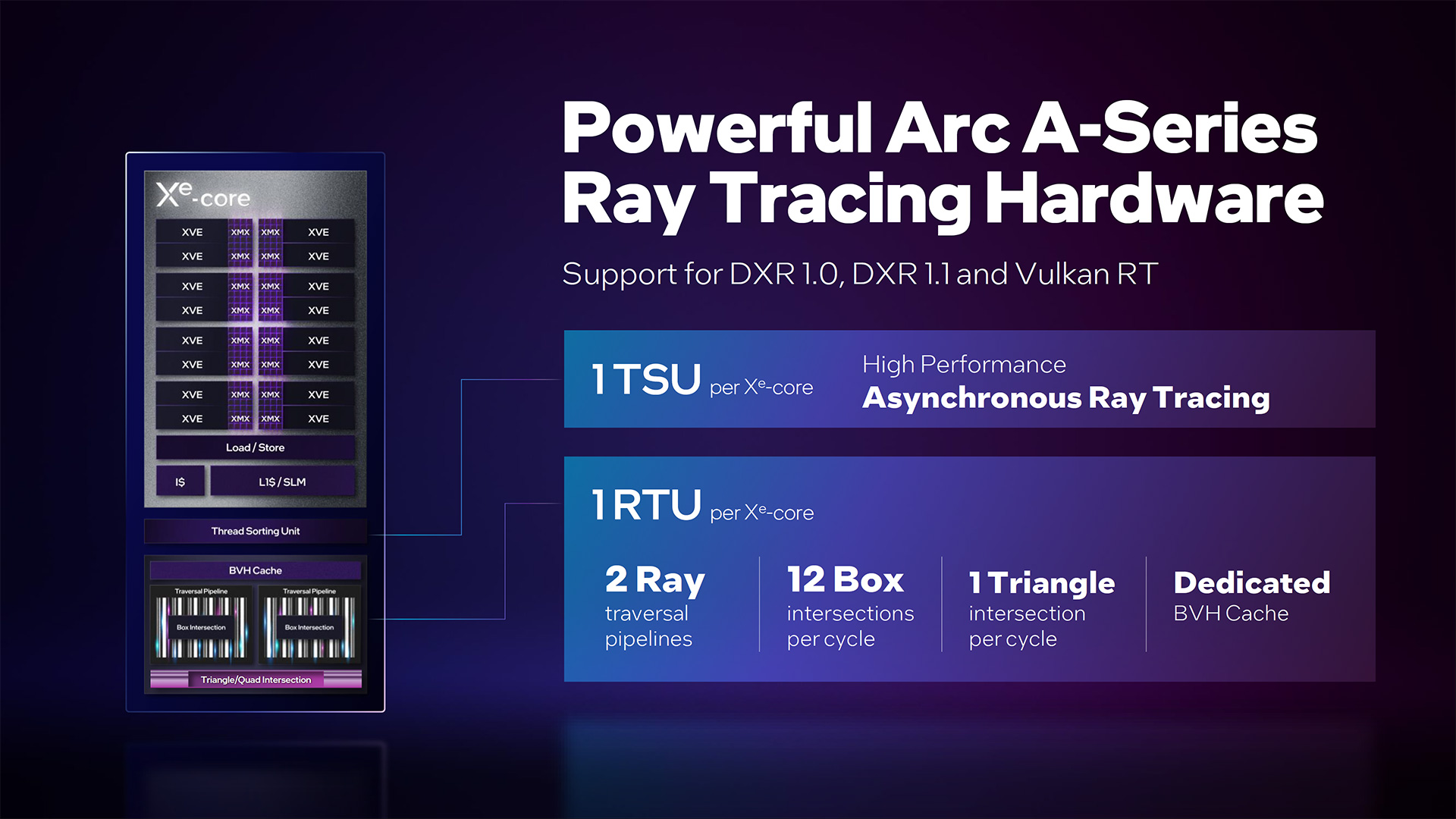

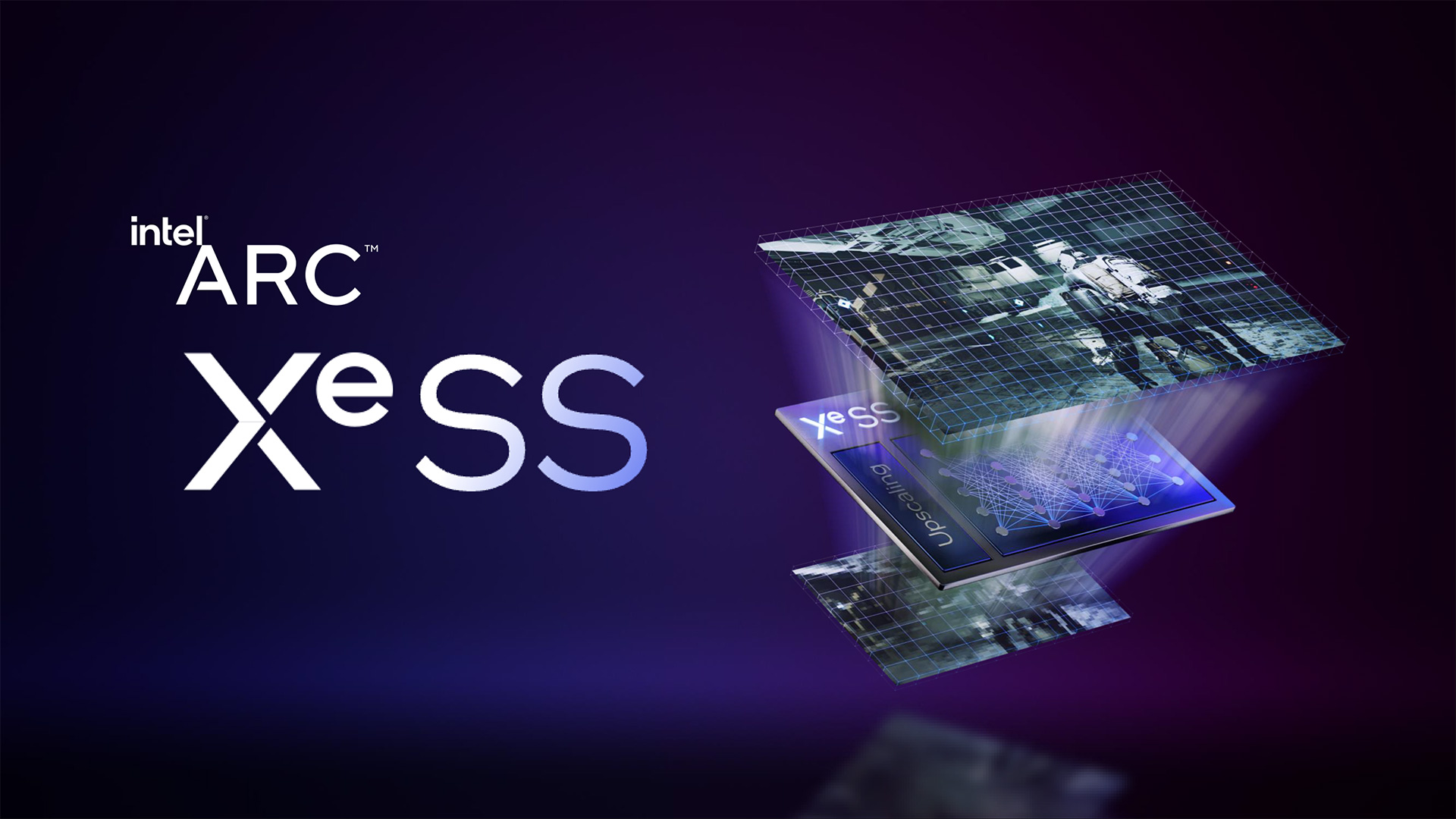
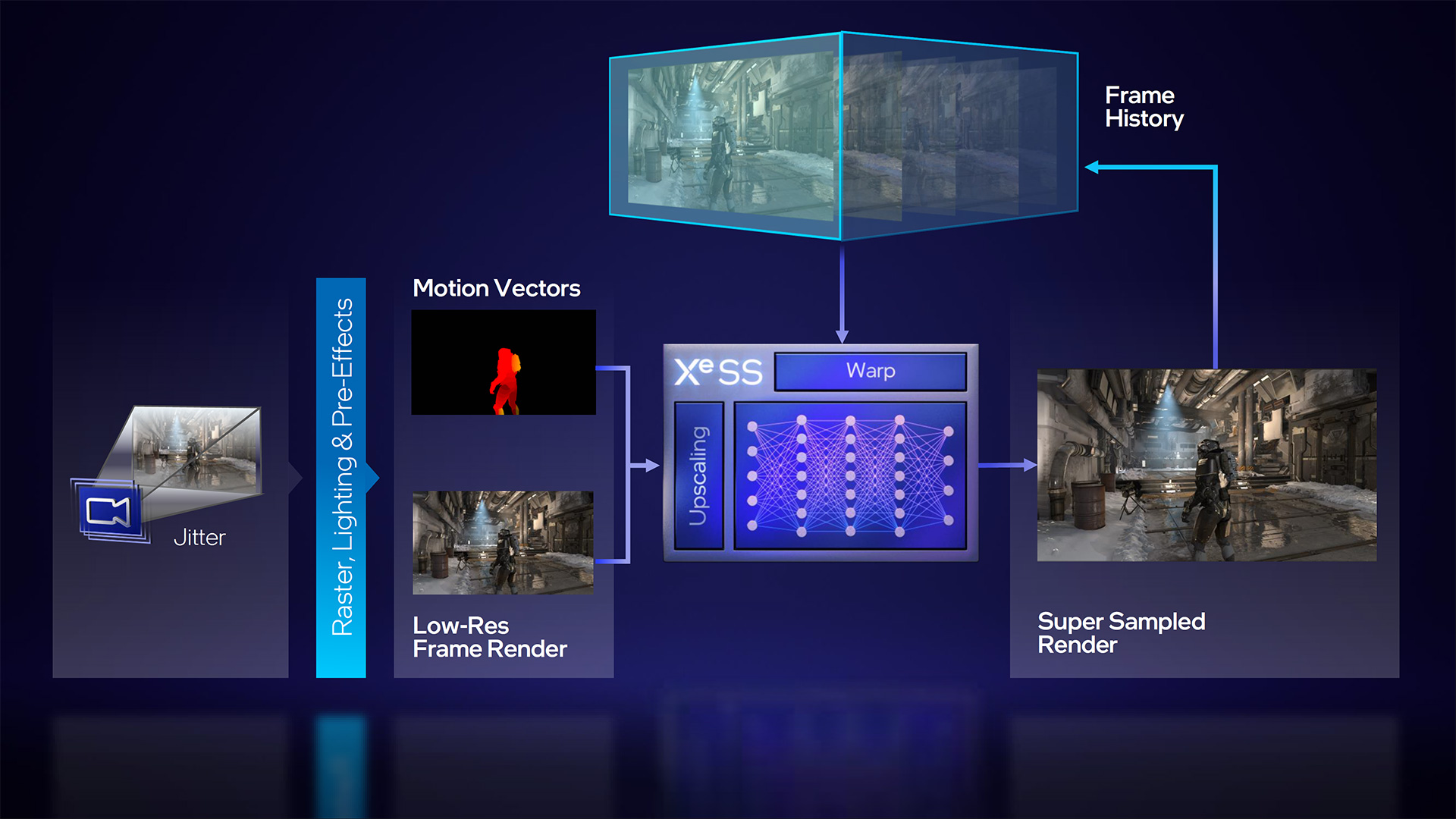
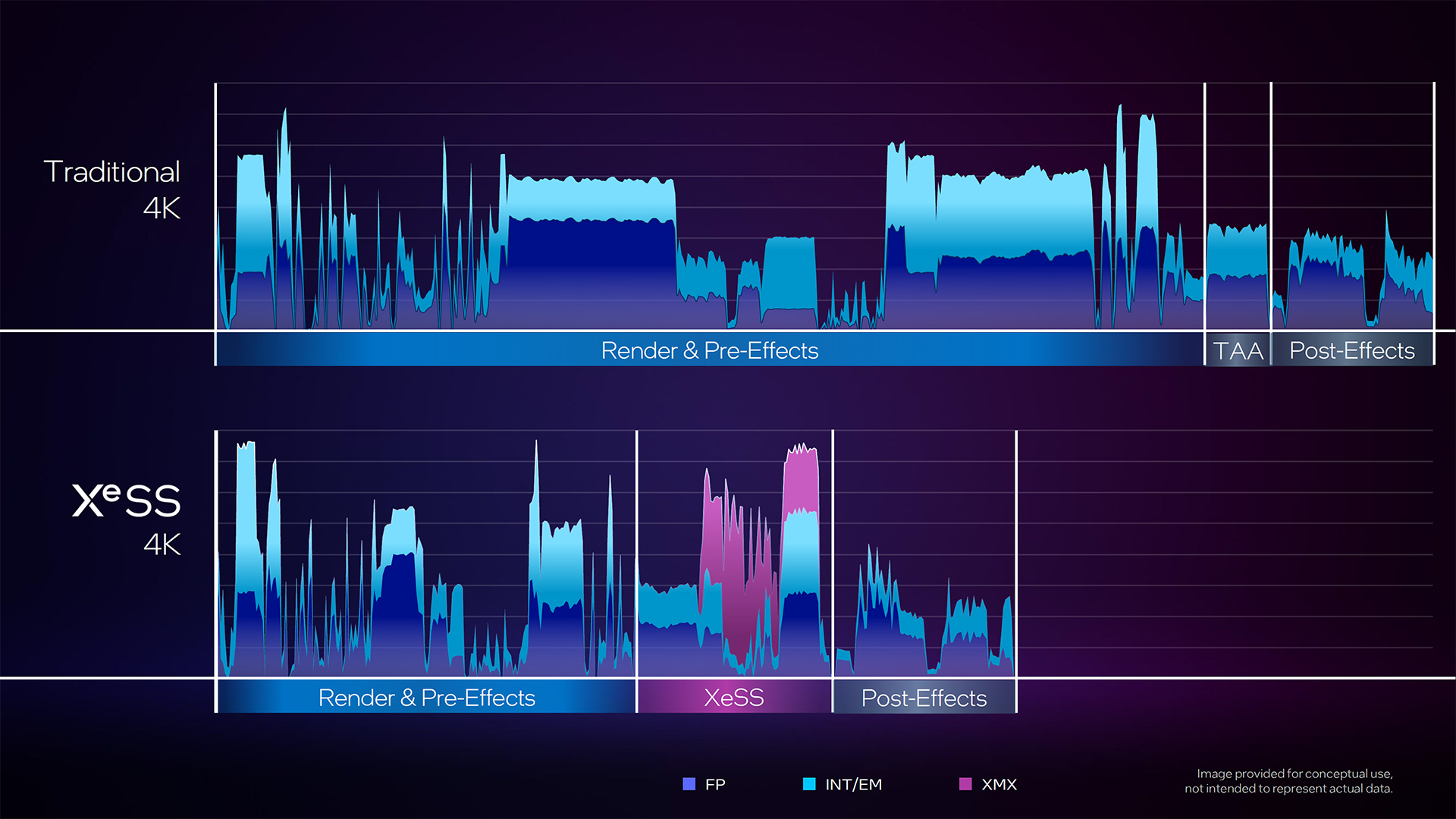


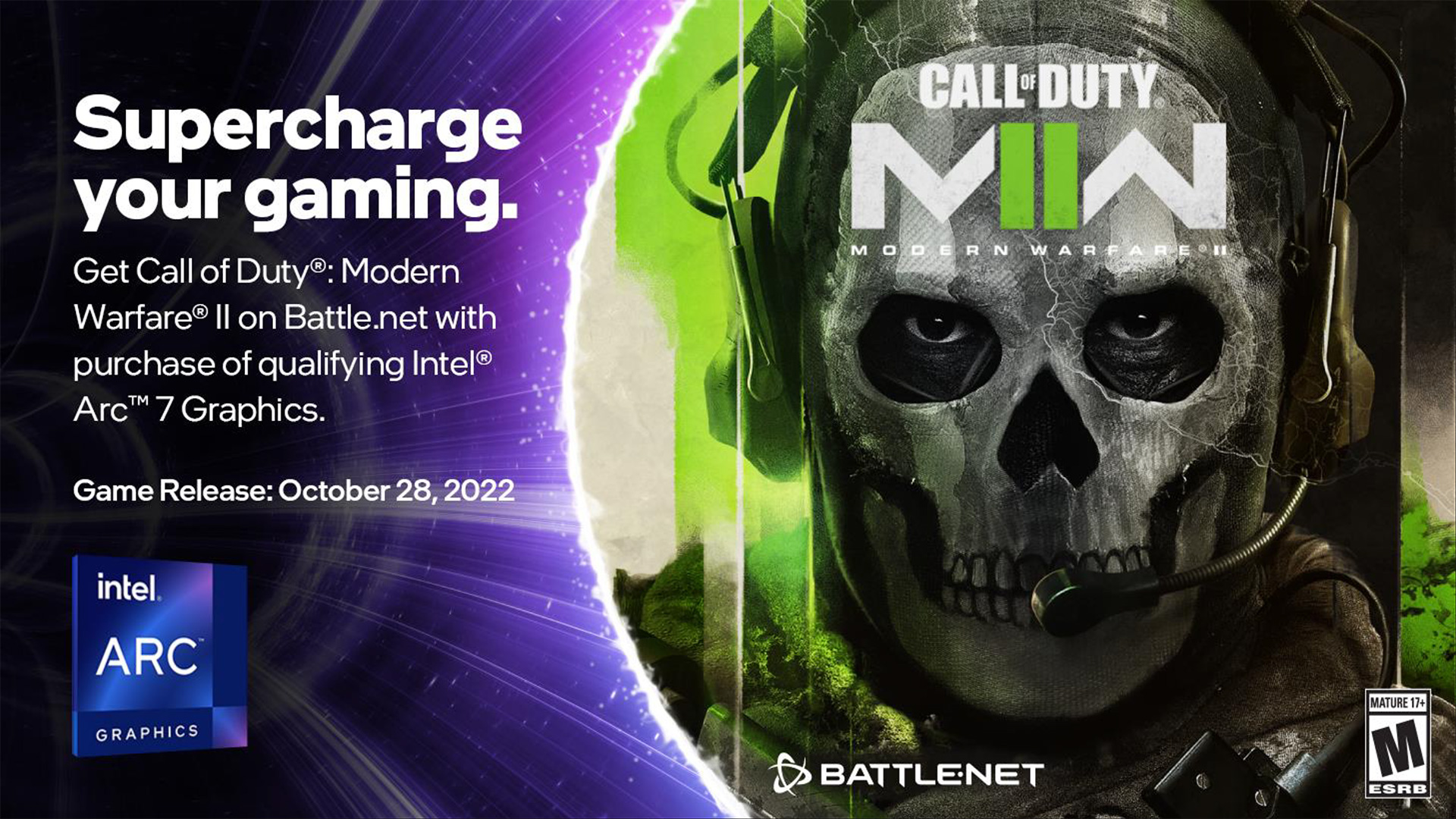
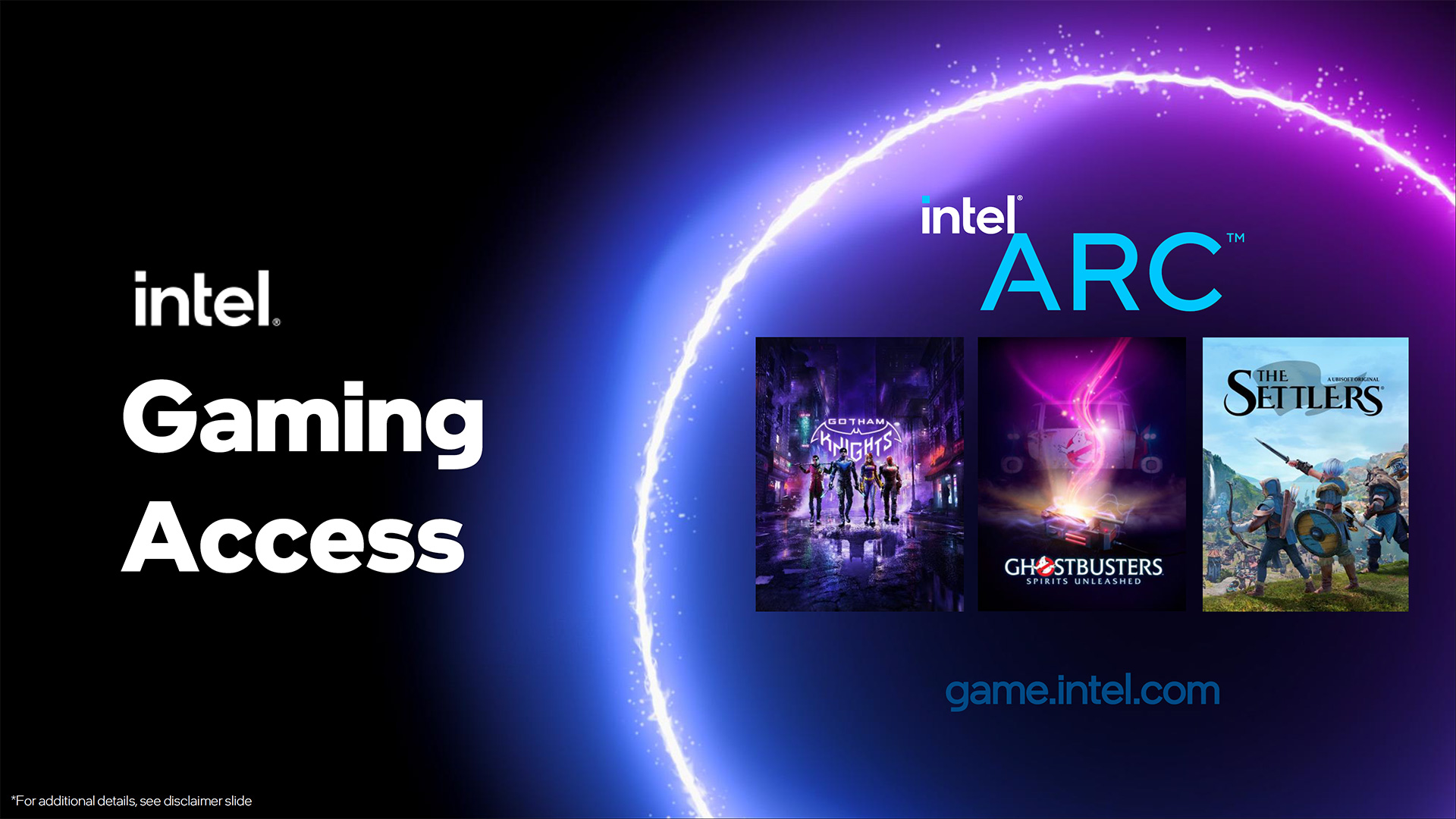
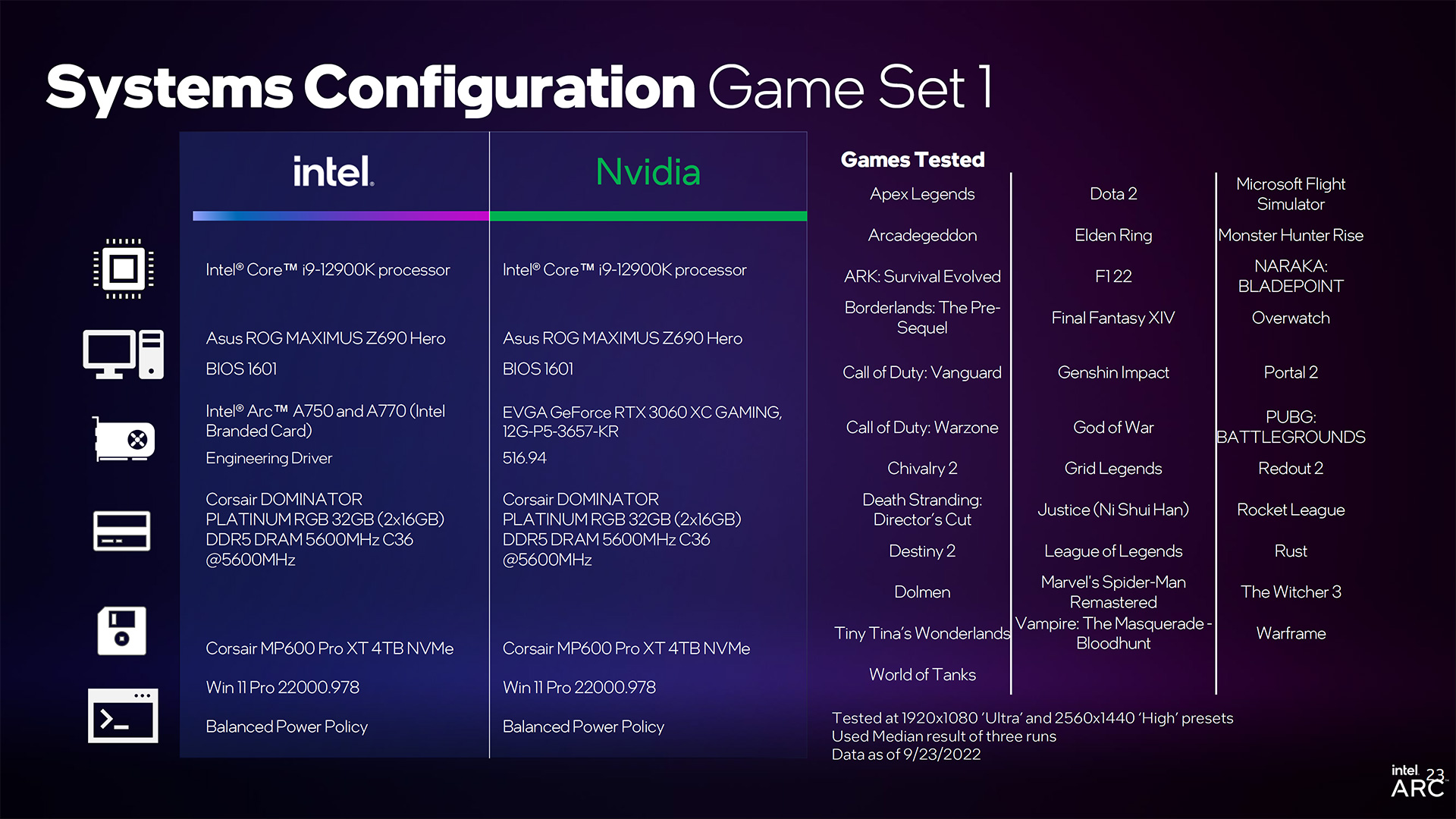
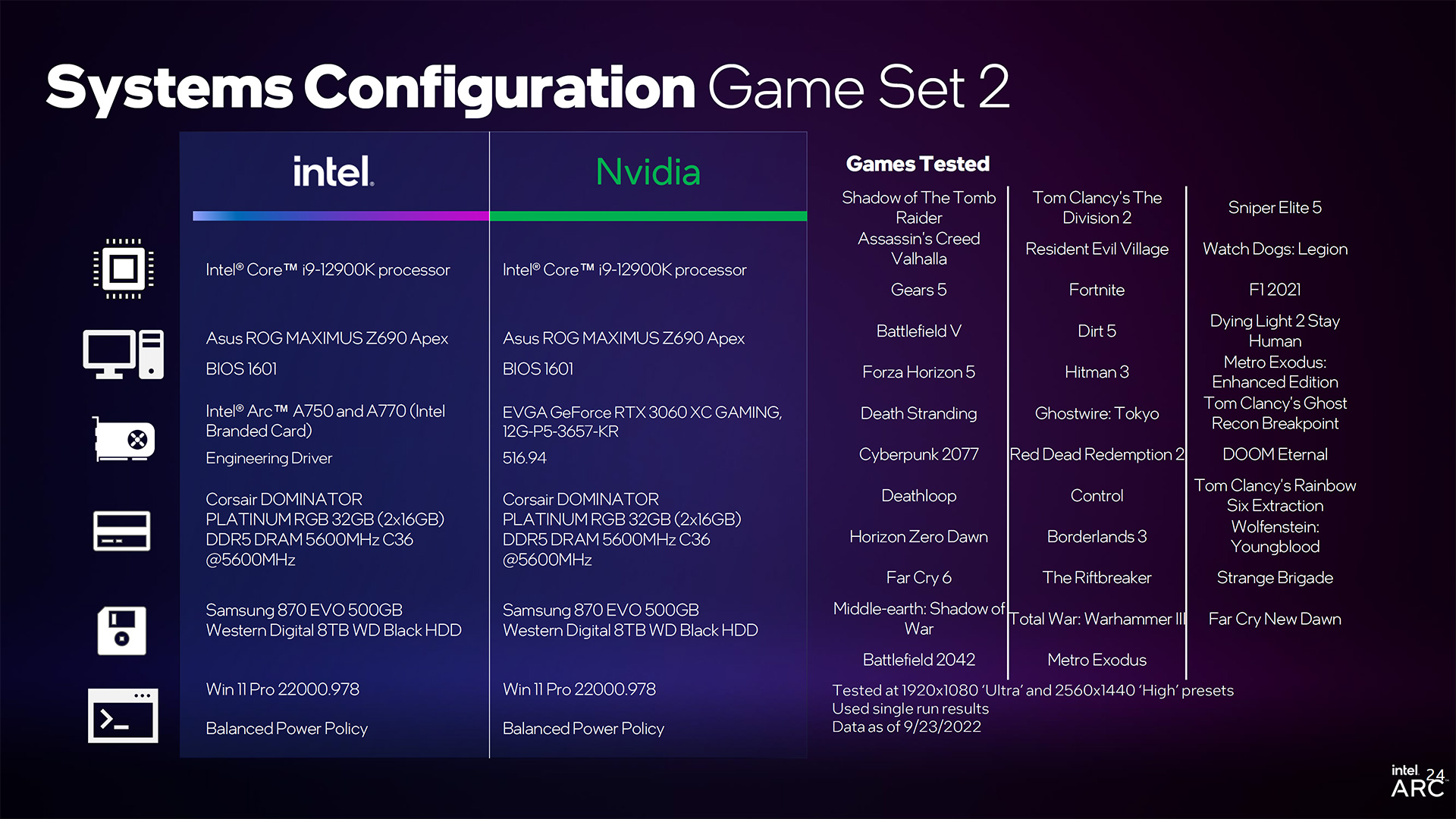
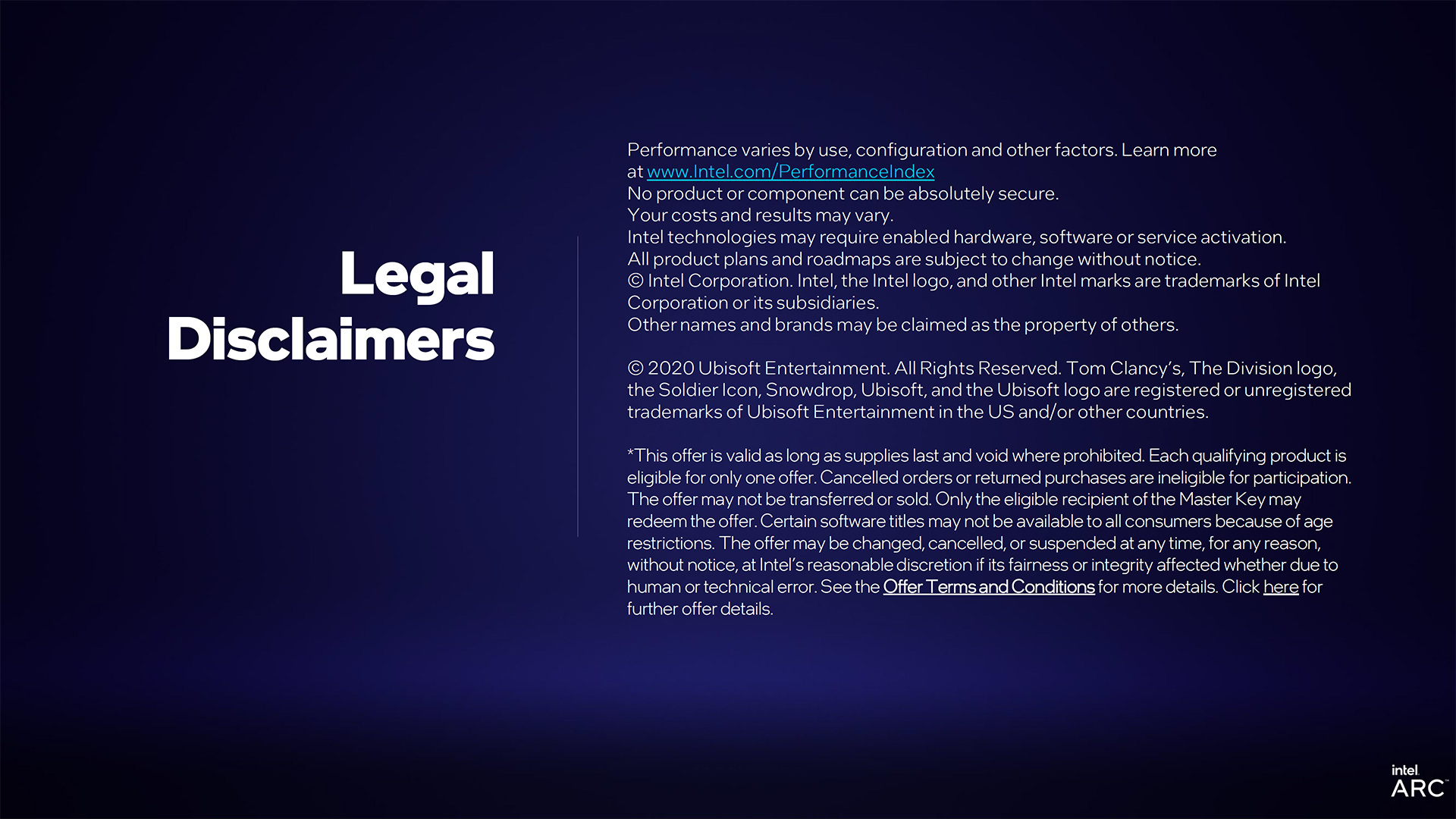

Jarred Walton is a senior editor at Tom's Hardware focusing on everything GPU. He has been working as a tech journalist since 2004, writing for AnandTech, Maximum PC, and PC Gamer. From the first S3 Virge '3D decelerators' to today's GPUs, Jarred keeps up with all the latest graphics trends and is the one to ask about game performance.
-
boe rhae I'm very hopeful this goes well for Intel. The disaster 40xx launch plus the EVGA exit and PSU confusion have made me very negative on nVidia for the first time. The way they lied-by-omission about how one of their 4080s is really a 4070 in disguise is pretty gross. Of course there's Radeon stuff, but if they explode in sales because of how nVidia fumbled this launch, then that opens up an opportunity for green and red to switch positions and the customer still loses.Reply
I'm hoping Intel can introduce more pressure on both companies to do right by their customers. Honestly I'm more excited for ARC than I am for anything else in tech right now, whether or not I actually buy one of the cards. -
InvalidError While the A750/770 may look somewhat promising, I'm really rooting for the A580 to provide great bang-per-buck to fill the huge gap between the sub-par A380 and the still somewhat pricey A750.Reply -
JarredWaltonGPU Reply
I suspect the A580 won't be too much cheaper than the A750. We'll see, but somewhere in the $229 to $249 range seems most likely. And if cards are actually available at those prices, and performance still easily beast the RTX 3050, that would be great. Can it beat AMD's RX 6600 though? 🤔InvalidError said:While the A750/770 may look somewhat promising, I'm really rooting for the A580 to provide great bang-per-buck to fill the huge gap between the sub-par A380 and the still somewhat pricey A750. -
ohio_buckeye If it's a performance level of a 3050 then no. But this should be a good thing for consumers especially as Nvidia is getting a bit uppity in pricing. Truth be told AMD would likely do it if they could. See socket AM5. But with 3 companies in competition hopefully they can provide value.Reply -
artk2219 So long as they've got the drivers in a decent state these cards should be alright, the real battle will be the with RX 6600 series though.Reply -
Makaveli Replyohio_buckeye said:See socket AM5.
AMD is not responsible for Vendor motherboard pricing.
that blame falls on asus, msi etc -
King_V Replyboe rhae said:Of course there's Radeon stuff, but if they explode in sales because of how nVidia fumbled this launch, then that opens up an opportunity for green and red to switch positions and the customer still loses.
Wait, I'm confused here. If AMD explodes in sales because of Nvidia fumbling, how is that "the customer loses"?
Or am I mis-reading this?
